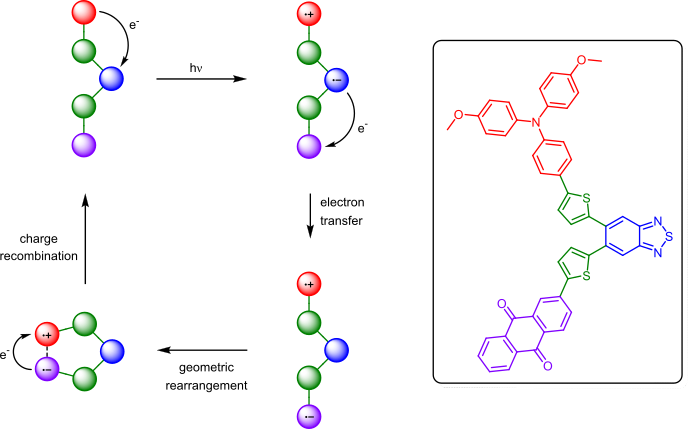A Proof-of-Concept for a Photoinitiated Single-Molecule Circuit
The ‘holy-grail’ of molecular electronics is the ability to develop fully-integrated molecular circuitry, and by extension, single-molecule circuitry.[1,2] The design principles for a molecular wire have already been well established,[3] but a molecular circuit represents a far greater challenge. A molecular wire must have charge transfer between two stations/electrodes, whereas a molecular circuit must have charge travel unidirectionally in a complete circuit and recombine at the origin. A molecular circuit also requires a controllable external field to initiate the flow of charge.
This presentation shall cover the design principles and spectroscopic characterisation of an electron donor-acceptor-acceptor (D-A-A) triad as a proof-of-concept photoinitiated molecular circuit (Figure 1), with a conservatively estimated quantum efficiency of 7.8%. This is achieved through three sequential charge-transfer processes, and the exploitation of geometric rearrangement in the excited state.

Figure 1. Proposed mechanism for the photoinitiated molecular circuit. Red = Donor, Blue = Acceptor 1, Purple = Acceptor 2, Green = Bridge.
[1] Sriharsha V. Aradhya, Latha Venkataraman, Nature Nanotechnology, 2013, 8, 399-410
[2] Timothy A. Su, Madhav Neupane, Michasel L. Steigerwald, Latha Venkataraman, Colin Nuckolls, Natrue Review Materials, 2016, 1, 1-15
[3] Annie Butler Ricks, Kristen E. Brown, Matthias Wenninger, Steven D. Karlen, Yuri A. Berlin, Dick T. Co, Michael R. Wasielewski, Journal of the American Chemical Society, 2012, 134, 4581-4588